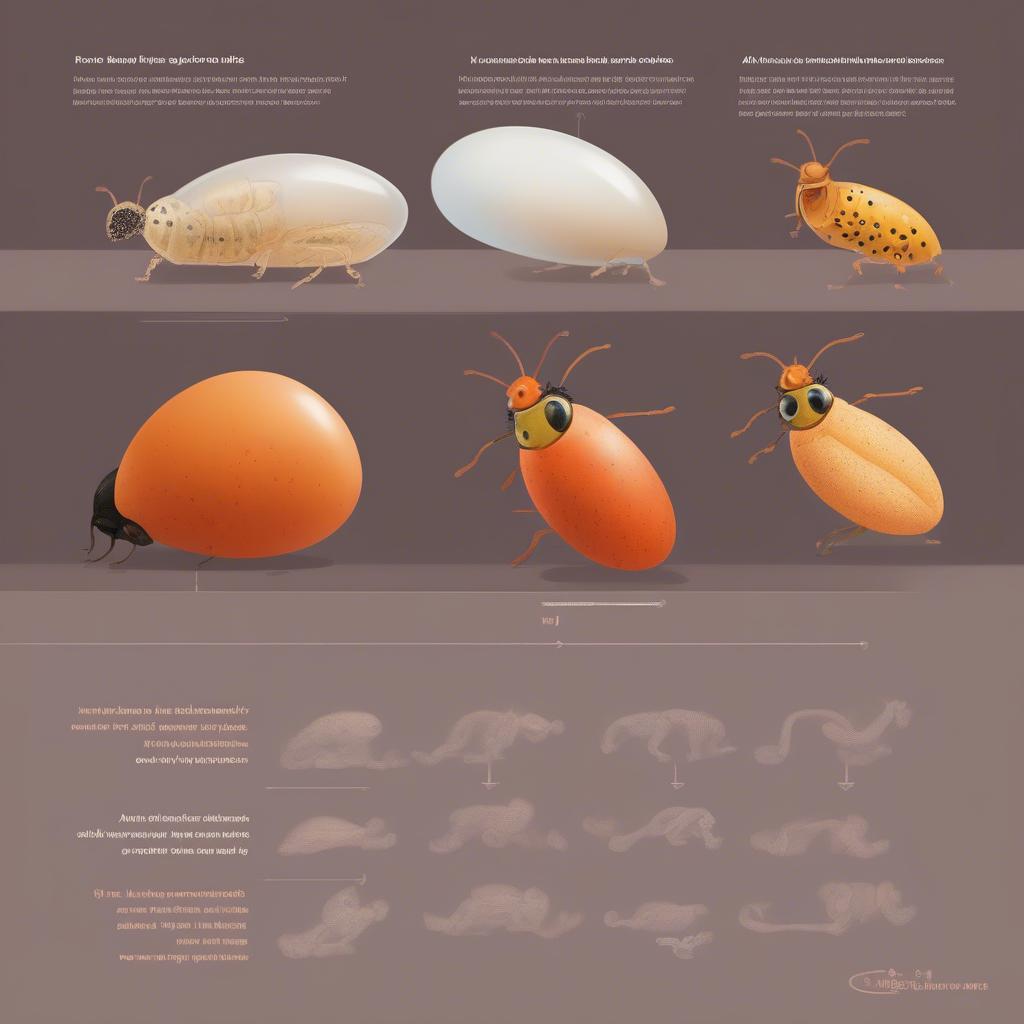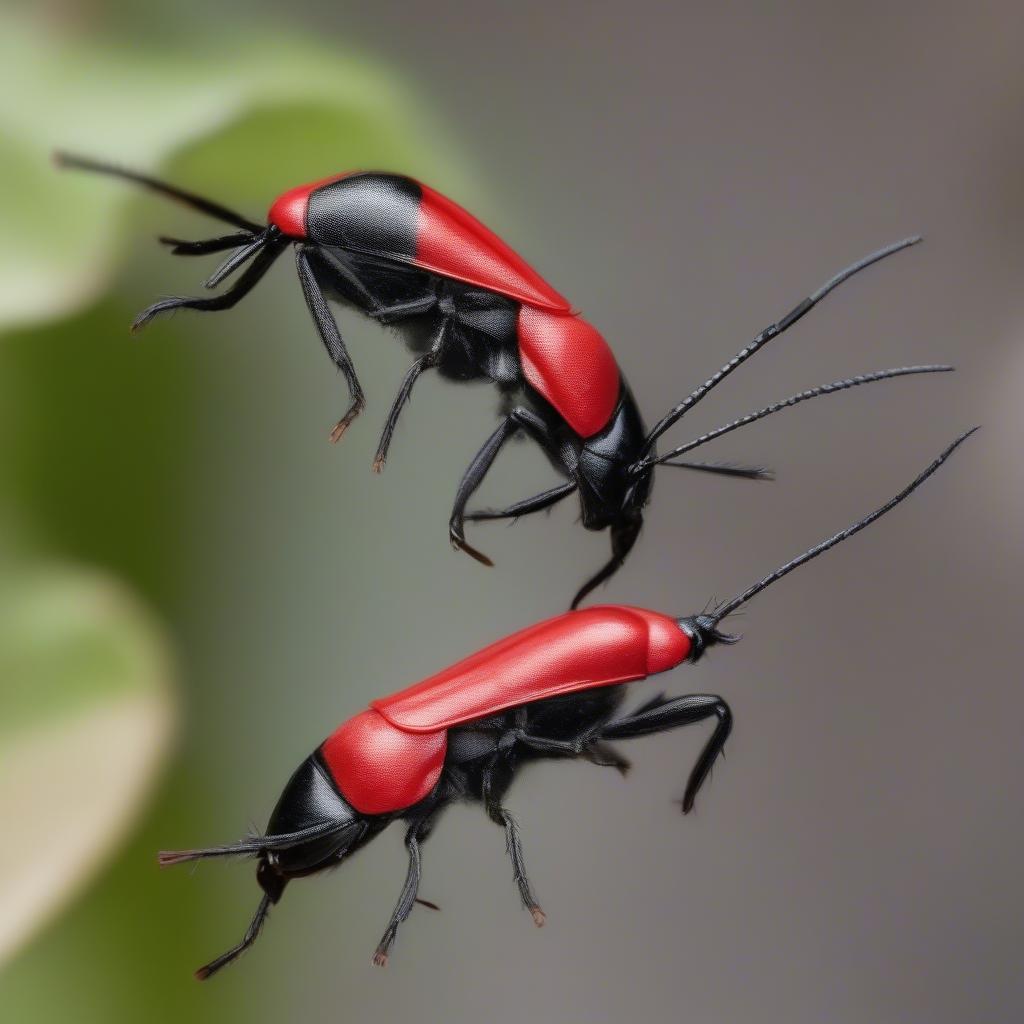Love bugs, those pesky black and red insects often seen coupled together in flight, are a common sight in many parts of the Americas. But what do love bugs do? Beyond their noticeable mating habits, what’s the real story behind these tiny creatures? This article delves into the fascinating world of love bugs, exploring their lifecycle, behaviors, and impact on the environment.
Understanding the Love Bug Lifecycle
Love bugs, also known as Plecia nearctica, are small flies belonging to the March fly family, Bibionidae. Their lifecycle consists of four stages: egg, larva, pupa, and adult. Female love bugs can lay hundreds of eggs in decaying vegetation, providing a food source for the emerging larvae. These larvae play a beneficial role in breaking down organic matter, contributing to nutrient cycling in the ecosystem. After the larval stage, they pupate in the soil before emerging as the familiar adult love bugs.  Love Bug Life Cycle Stages
Love Bug Life Cycle Stages
The “Love” in Love Bugs: Mating Habits and Behaviors
The most distinctive feature of love bugs is their prolonged mating behavior. Adult love bugs are often seen flying attached to each other, remaining connected for several days, even during flight and feeding. This extended coupling ensures successful fertilization of the eggs. What Do Love Bugs Do while attached? Primarily, they mate and search for suitable egg-laying locations. This conspicuous pairing has earned them their common name, “love bugs.”  Love Bugs Mating in Flight
Love Bugs Mating in Flight
Are Love Bugs Harmful? Debunking the Myths
While they can be a nuisance, love bugs are largely harmless. They don’t bite or sting humans, and their primary food source is nectar and pollen. However, their sheer numbers during mating season can cause issues for drivers. The splattered remains of love bugs on car windshields and grills can be difficult to remove and can even damage car paint if left unattended.
What Do Love Bugs Do to Cars?
The acidic body fluids of love bugs can etch car paint if not cleaned promptly. This is why it’s important to wash your car soon after driving through a swarm of love bugs. What do love bugs do to affect visibility? Large numbers of splattered love bugs can also obscure visibility, making driving hazardous. Using a specialized bug remover can help protect your car’s finish.
Love Bugs and the Environment: Friend or Foe?
Love bugs play a crucial role in decomposing organic matter, enriching the soil, and contributing to a healthy ecosystem. While they might be considered a nuisance during mating season, their overall impact is beneficial. What do love bugs do for the environment? They help break down dead plant material, contributing to nutrient cycling in the environment.
Managing Love Bug Populations
Despite their beneficial role, large swarms of love bugs can be problematic. Understanding their lifecycle and behavior can help in managing their populations. Avoiding driving during peak mating seasons can minimize car damage. What do love bugs do to impact traffic? Their large swarms can reduce visibility and cause traffic delays. Checking local forecasts for love bug activity can help drivers plan their trips accordingly.
Conclusion: The Intriguing World of Love Bugs
Love bugs, while sometimes considered a nuisance, are fascinating insects with a crucial role in the ecosystem. Understanding their lifecycle, mating habits, and impact on the environment can help us appreciate these unique creatures. So, what do love bugs do? They mate, they contribute to the environment, and they remind us of the interconnectedness of nature.
Expert Insights:
Dr. Emily Carter, Entomologist: “Love bugs demonstrate a remarkable mating strategy, showcasing the diversity of insect behavior.”
Professor David Miller, Ecologist: “The larvae of love bugs are essential decomposers, contributing to the health and vitality of our ecosystems.”
Dr. Sarah Johnson, Environmental Scientist: “Understanding the role of love bugs in the environment is key to developing effective management strategies.”
FAQs
- Do love bugs bite? No, love bugs do not bite or sting humans.
- Are love bugs harmful to plants? No, love bugs primarily feed on nectar and pollen. Their larvae feed on decaying vegetation, contributing to nutrient cycling.
- How can I remove love bugs from my car? Use a specialized bug remover and wash your car promptly.
- When is love bug season? Love bug season typically occurs twice a year, in spring and late summer.
- What attracts love bugs? Love bugs are attracted to light-colored surfaces and exhaust fumes.
- Where do love bugs live? Love bugs are primarily found in parts of Central America and the southeastern United States.
- What do love bugs eat? Adult love bugs feed on nectar and pollen, while their larvae feed on decaying vegetation.
For further assistance, please contact us at Email: contact@daiduongtranhba.com, address: Michigan Ave, Suite 3100, Chicago, IL 60611, USA. We have a 24/7 customer support team.

